Polish Way of the Cross
Polish Way of the Cross
HAP Grieshaber's Polish Way of the Cross
– Father Johann G. Roten, S.M.
The two expressions, representation and identification, are key words of the artistic program of Expressionist art.
Expressionism, if it were possible to reduce this multi-form movement to a common denominator, takes the past and its stories and recreates them for the present. However, the story is no longer a succession of events separated by the logic of space and time. Narration becomes representation, the story is abbreviated until it fits the concise space of the icon. Using to a maximum the expressive power of reduced pictorial form, Expressionism delivers a message where details and the narrative movement are abandoned for the sake of what counts most - the essential. Representing the essential, Expressionism wants it to be pondered and assimilated. Expressionist art has reached its goal when it succeeds in achieving identification between the artwork and the onlooker. Expressionism is committed art, and in turn, it wants commitment from those who approach it.
We have a typical example of such a program and expectations in the Polish Way of the Cross created in 1967 and 1969. Intended originally to adorn the Church of the Atonement in Auschwitz, a project which never saw the light of day, the Polish Stations are, in some way, an example of collaboration between art and church. Grieshaber's woodcuts, for which he cut his own blocks, were published in 1967 upon request of the artist, together with the text of the Way of the Cross written by Cardinal Wyszynski. The 1967 publication, limited to fifty copies, bears the title: HAP Grieshaber, Way of the Cross. Meditations by Stephen Cardinal Wyszynski. The series of fourteen woodcuts exhibited here corresponds to number 25/50.
We are presenting Grieshaber's fourteen stations with the idea of shared experience in mind. As mentioned in the beginning, Expressionist art seeks actualization in its reader or spectator. Actualization happens when representation leads to identification. Thus, after pointing to the biblical or apocryphal roots of each station (Roots), this presentation of the Way of the Cross will suggest some of the major expressive pictorial elements (Representation), and invite the reader to attempt identification with the message (Identification).
First Station: Condemned to Death
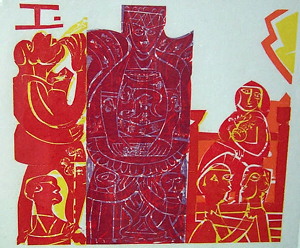
Roots
When the chief priests and the officers saw him, they cried out, "Crucify him, crucify him!" Pilate said to them, "Take him yourselves and crucify him, for I find no crime in him." John 19:6
Representation
Red upon red, vilified or lightened by yellow. Poisonous anger to the left of Pilate, idle curiosity and anguished premonition on his right. Pilate himself is the image of heavy-lined chaos: the chaos of conflicting emotions, allegiances, and truth. But where is Jesus?
Identification
Jesus’ face is never seen in this Way of the Cross. He is absent altogether from the First Station. So, who is the victim of anger, injustice or indifference? Is there an open slot for me, maybe even a gap? Frightened? "Who will separate us from the love of Christ? Trial, or distress, or persecution, or hunger, or nakedness, or danger, or the sword?" (Romans 8:35)
Second Station: Carrying the Cross
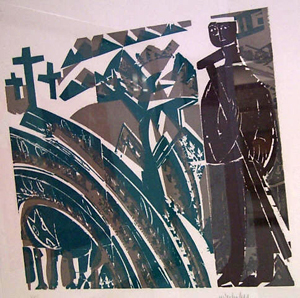
Roots
The Jews answered him, "We have a law, and by that law he ought to die, because he has made himself the Son of God." John 19:7
Representation
Golgotha, in the upper left corner, seems very far and insignificant, swallowed up almost by the flying buttresses of still another tower of Babel beneath. In the lower left corner, the lamb of God is being crushed by the weight of the universe. But who is the black figure in the far right portion of the Second Station?
Identification
Black and in street clothes, the figure stands for each one of us, including Jesus. Thanks to him the cross is now a crutch and staff, for Golgotha is a long, long way ahead. But we are riding on the back of the lamb, symbol of victory over death.
Third Station: The First Fall
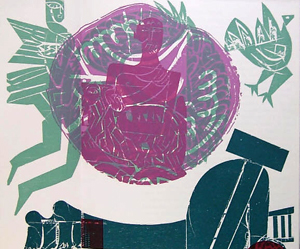
Roots
The idea of the first fall, not mentioned in Scripture, is traceable to ca. 1475 (Bethlehem). Isaiah speaks of the suffering servant: Surely he has borne our griefs and carried our sorrows; yet we esteemed him stricken, smitten by God, and afflicted. Isaiah 53:4
Representation
Flattened to the ground and convulsing in helpless struggle, the bearer of the cross is seeing, in his fevered imagination, visions of betrayal (flying rooster), of injustice (Pilate in a time capsule), and abandonment (the angel of God indifferently flying by). What help is there in the cross?
Identification
The cross is like a giant nail pinning us to the ground of our human condition. Not only sign of victory and redemption, the cross is also a mark of shame and defeat. In this sign, joy and shame are reconciled.
Fourth Station: Encounter with the Mother
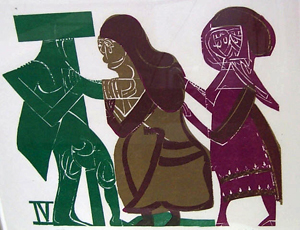
Roots
The encounter with his mother, not recorded in the Bible, seems first commemorated in 1296 (Riccoldo). Mary knew that her child would be a "sign that is rejected" and that her heart would be pierced by a sword: And a sword will pierce through your own soul also, that thoughts out of many hearts may be revealed. Luke 2:35
Representation
The mother seems to hasten against a wall of ice and steel. The green and angular forms of the cross-bearer may also speak of hardened resolve and hope. There is no opposition between mother and son, between brown and green. Tenuous as it may appear, the complementarity between resolve and compassion is present and bitterly needed. See the flowers of love blossoming on the robe of the third figure, a woman with helping hands. Redemption is a labor of love, it says.
Identification
We are actors in the drama of human history. The roles are varied but they are begging each other’s genius. For me, will it be the greening of my shared hope, or the meek and subdued colors of compassion? Both of them must have roots anchored in love.
Fifth Station: Simon of Cyrene
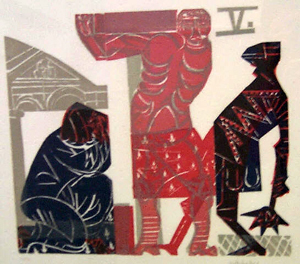
Roots
But not so with you; rather let the greatest among you become as the youngest, and the leader as one who serves. Luke 22:26
Representation
Selflessness and service have the colors of life. They strengthen the soul and give the person new stature – as seen in the figure of Simon of Cyrene. Placed between brutal force and pitiful exhaustion, he stands upright and firm. Again, there are little flowers of love giving an inkling of the deeper motives for his action.
Identification
To be commissioned for something limits our freedom, but gives a sense of belonging and solidarity. It is a source of growth, that of others and my own. Commissioned, we need to walk a fine line between brutal force and pitiful weakness.
Sixth Station: Veronica
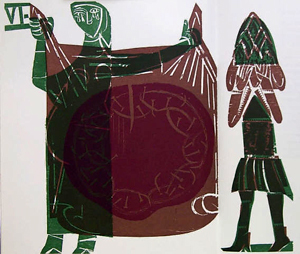
Roots
The scene with Veronica is not of biblical origin, but there is a long tradition based on Scripture asking God to show us his face: Thou hast said, "Seek ye my face." My heart says to thee, "Thy face, Lord, do I seek." Psalm 27:8
Representation
The weeping Veronica is holding an oversized linen, wide enough to cover the dolors of creation. But no face is visible, neither that of the Ecce Homo nor the flayed face of humanity. Instead, the shroud bears the marks of a giant crown of thorns. Whose crown is this?
Identification
Is this shroud an urgent invitation to take up my crown of thorns? Is it a veiled accusation about suffering caused to my neighbor? The little figure in the margin, hiding its face and wearing a dunce cap or magic hood, is like my silly alter ego contemplating flight.
Seventh Station: The Second Fall
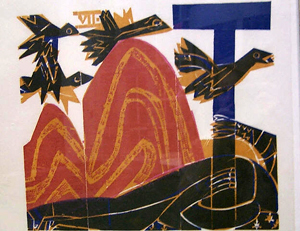
Roots
A fall at the gate of the city is indicated in 1283 (Burchard). The Bible, however, doesn’t make mention of it. The theme of the abasement of God is amply known: But I am a worm, and no man; scorned by men, and despised by the people. Psalm 22:6
Representation
The mood is somber. Blackbirds are flying over the mountains; the road seems endless. This is the life perspective of the fallen figure holding on to the cross.
Identification
Sometimes a giant nail that pins us to the ground, the cross can be a prop and a pillar. It is also the blue staff of my soul, as in this station, reaching higher than the highest mountain. We may say: "My flesh will dwell in hope. For you will not abandon my soul to Hades." (Acts 2:26-27; Psalm 16:9-10)
Eighth Station: The Wailing Women
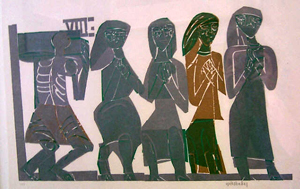
Roots
And there followed him a great multitude of the people, and of women who bewailed and lamented him. But Jesus turning to them said, "Daughters of Jerusalem, do not weep for me, but weep for yourselves and for your children. For behold, the days are coming when they will say, ‘Blessed are the barren, and the wombs that never bore, and the breasts that never gave suck!’" Luke 23:27-29
Representation
The wailing women are standing in line. A line, alas, of separate worlds. Icons of sorrow, they seem absorbed in their own suffering. Are they lacking a deeper sense of Christ’s Way of the Cross? There is a green lining of hope traversing their figures and that of the Suffering Servant. Eventually, his message will reach their senses, but even now his knees are buckling under the weight of a cross that has never been heavier.
Identification
Frequently, suffering leads to avoidance, and we make dolor our sole companion. Wrapping ourselves within an impenetrable shroud of self-pity, we retreat from life. Human hardship is always a shared experience. I need to understand its deeper meaning; only then will suffering become a harbinger of days of peace and joy.
Ninth Station: The Third Fall
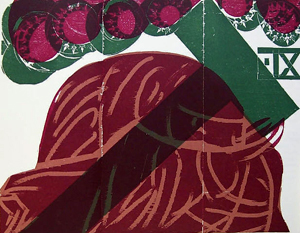
Roots
In the fourteenth century there exist mentions (Verona and Poggibonsi) of a stone in the courtyard of the Holy Sepulcher Church upon which Jesus fell. Psalm 69 translates some of Jesus’ shame and disgrace: Thou knowest my reproach, and my shame and my dishonour; my foes are all known to thee. Insults have broken my heart, so that I am in despair. I looked for pity, but there was none; and for comforters, but I found none. Psalm 69:19-20
Representation
Mountains are no longer the only obstacles on the Way of the Cross. The Suffering Servant himself has become a mountain and an obstacle on his road. He is a mountain of sorrows, a pitiful and amorphous clump of human misery. His abasement is sealed with the pitiless sign of his mission – the cross. But heaven unfurls with a cascade of mystical flowers, passion flowers maybe. Their hearts are the color of blood, but their green petals are harboring promise.
Identification
"Apart from the cross there is no other ladder by which we may get into heaven." (Rose of Lima) Christians, we hail the cross as "our only hope" (Hymn Vexilla Regis). Christ was even more explicit. He wants me to take up my cross and follow him (Matthew 16:24) – provided I will accept to be his disciple.
Tenth Station: Stripping of the Robe
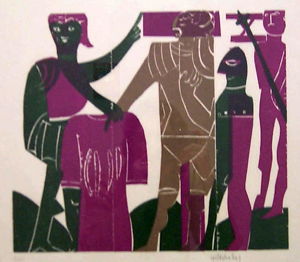
Roots
And when they came to a place called Golgotha (which means the place of a skull), they offered him wine to drink, mingled with gall; but when he tasted it, he would not drink it. And when they had crucified him, they divided his garments among them by casting lots. Matthew 27:33-35
Representation
Disrobed, his head hidden by the horizontal beam of the cross, the Suffering Servant, in all his nakedness, remains an imposing image of life and truth. His robe, still intact and red, has the meaning of the free offering of his life. Washed with his blood, it is also the sign that he gave his life as "a ransom for many."
Identification
Christ gave his blood-red robe to me and all his followers, so that we might wear it as a garment of light. It is like a warranty of eternal life, but, at the same time, a challenge to share the promise of eternal life in the time which is ours.
Eleventh Station: Nailing to the Cross
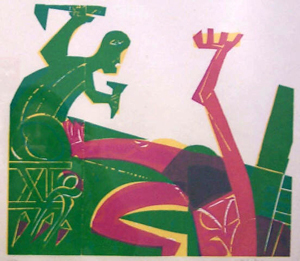
Roots
And when they came to the place which is called The Skull, there they crucified him, and the criminals, one on the right and one on the left. And Jesus said, "Father, forgive them; for they know not what they do." And they cast lots to divide his garments. And the people stood by, watching; but the rulers scoffed at him, saying "He saved others; let him save himself, if he is the Christ of God, his Chosen One!" Luke 23:33-35
Representation
Two colors, two movements. One of aggressive green, the other a tender and vulnerable pink and yellow. The green color highlights a brutish face, an oversized nail, and hammer. It stigmatizes the massive cross as the ultimate negation of life. Placed on this altar of aggressive death, the dislocated members of the Suffering Servant are trembling in senseless torture and pain. Faceless and helpless, as the tender pink and yellow colors suggest, he is now indeed a worm and no man.
Identification
Human life is full of green and pink dichotomies, not least because I, too, have two souls in my body: one that belongs to the brutish face with nail and hammer, the other trembling in helpless need for truth, goodness, and beauty.
Twelfth Station: Crucifixion
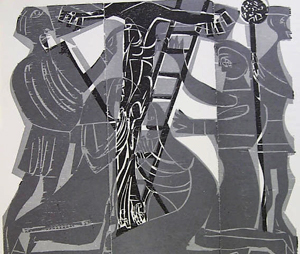
Roots
So the soldiers did this. But standing by the cross of Jesus were his mother and his mother’s sister, Mary the wife of Clopas, and Mary Magdalene. When Jesus saw his mother and the disciple whom he loved standing near, he said to his mother, "Woman, behold, your son!" Then he said to the disciple, "Behold, your mother!" And from that hour the disciple took her to his own home . . . When Jesus had received the vinegar, he said, "It is finished;" and he bowed his head and gave up his spirit . . . But one of the soldiers pierced his side with a spear, and at once there came out blood and water. John 19:25-27, 30, 34
Representation
A purified version of the classical representation of the Arma Christi motif (the tools of Christ’s suffering: ladder, lance, nails, etc.), this crucifixion is further a tribute to Christ triumph over death. His head (invisible as always!) is no longer part of his suffering body, and the body itself, slim and almost sleek, suggests a powerful upsurge and breaking out of the confined space in which it has been imprisoned. The figures surround the cross, and, painted in luminous greys and tender blacks, are like a silent ballet accompanying the Savior on his journey beyond.
Identification
There is a place for me in this ballet, if I am able to grasp the essential truth of human life as it is embodied in Christ’s Passion, Death, and Resurrection.
Thirteenth Station: Pietà
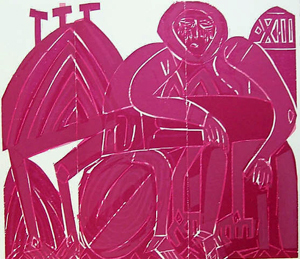
Roots
After this, Joseph of Arimathea, who was a disciple of Jesus, but secretly, for fear of the Jews, asked Pilate that he might take away the body of Jesus, and Pilate gave him leave. So he came and took away his body. Nicodemus also, who had at first come to him by night, came bringing a mixture of myrrh and aloes, about a hundred pounds’ weight. John 19:38-39
Representation
Grieshaber’s Pietà stands in cruel opposition to his crucifixion. The subdued and serene atmosphere of Christ’s death mutates into a scene of bloody horror and shrill lamentation. Everything in this woodcut is monumental: the bodies, the revolt, the grief, and the strength of the mother. A peasant woman as to her physical appearance, she is in fact the mother of all mothers, wrestling the remains of life from the tentacular arms of death. But Jesus has truly passed on; he is no longer present in this gruesome shell. What Mary fiercely embraces is not a corpse but the life divine she is carrying in her heart.
Identification
Love is a multi-splendored thing, but never lame. Love is fierce in passion and dedication. Love professed and love kept silent – we don’t know which one of them is burning most. Fierce in action and fierce in prayer, it never loses sight of the beloved; love likes life, and thus the struggle is fiercest when the light is dimming and the salt grows stale. I am no Mary, no Magna Mater, but I am not, either, a lame duck of love.
Fourteenth Station: Entombment
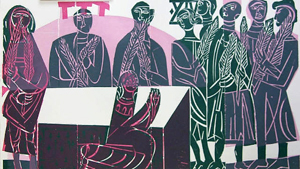
Roots
They took the body of Jesus, and bound it in linen cloths with the spices, as is the burial custom of the Jews. Now in the place where he was crucified there was a garden, and in the garden a new tomb where no one had ever been laid. So because of the Jewish day of Preparation, as the tomb was close at hand, they laid Jesus there. John 19:40-42
Representation
Golgotha is retreating into the background. Christ’s death takes on a new meaning, that of a memorial of faith and everlasting presence. The solemn figures in somber attire, carrying in their hands the palms of victory, have not gathered to commemorate death but to celebrate life. For the monumental tomb is open and filled with brilliant emptiness. Grieshaber’s entombment is a scene of anticipated resurrection. The grave faces standing around the tomb know: He is not dead, he lives. There is only one figure, perhaps Mary Magdalene, who wrings her hands and is still grieving.
Identification
There is still need for a Mary Magdalene, an empty tomb, and palms of victory. One single voice will never be able to express the fullness of this good news. Will it be my role to carry palms of victory or to grieve over human stubbornness? Whatever the call, it should never be diverted from the brilliant light that shines from the tomb.
All About Mary includes a variety of content, much of which reflects the expertise, interpretations and opinions of the individual authors and not necessarily of the Marian Library or the University of Dayton. Please share feedback or suggestions with marianlibrary@udayton.edu.
